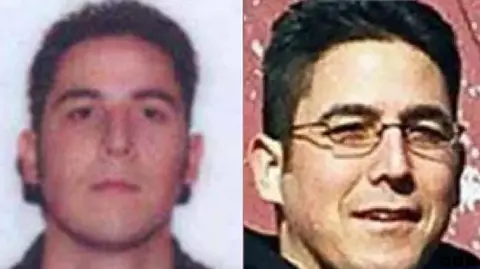A suspected double bomber on the FBI's most wanted list who vanished for 21 years is due in court this week to decide if he will be sent back to the United States to face trial.
The FBI believe Daniel Andreas San Diego has links to animal rights extremist groups and is their prime suspect for a series of bombings in the San Francisco Bay Area in 2003. Former FBI agents have said there were missed opportunities to arrest the 47-year-old before he vanished and claim they found a suspected bomb-making factory in his abandoned car after what detectives called a 65-mile (104km) rush-hour chase in California.
Mr. San Diego was found 5,000 miles (8,000km) away in a cottage in north Wales last year. Now he faces a five-day extradition hearing at Westminster Magistrates Court in London to determine if he will be sent back to the U.S. to answer a federal arrest warrant.
San Diego, the first American-born suspect on the FBI's most wanted terrorist list, has been indicted for maliciously damaging and destroying by means of an explosive after two separate attacks in 2003. The double bombing incidents occurred in the San Francisco area, targeting biotechnology firms affiliated with animal testing.
Despite the FBI's extensive efforts, including tracking San Diego's associates, he managed to evade capture for two decades, indicating the challenges faced by law enforcement in tracking international fugitives. The case underscores the complexity of tracking individuals who have demonstrated the capability and willingness to commit violent acts under the guise of political and social extremism.
Now, with his arrest, many questions arise about the failures in the investigation that allowed him to remain free for so long and what consequences this will have for similar cases in the future.
The FBI believe Daniel Andreas San Diego has links to animal rights extremist groups and is their prime suspect for a series of bombings in the San Francisco Bay Area in 2003. Former FBI agents have said there were missed opportunities to arrest the 47-year-old before he vanished and claim they found a suspected bomb-making factory in his abandoned car after what detectives called a 65-mile (104km) rush-hour chase in California.
Mr. San Diego was found 5,000 miles (8,000km) away in a cottage in north Wales last year. Now he faces a five-day extradition hearing at Westminster Magistrates Court in London to determine if he will be sent back to the U.S. to answer a federal arrest warrant.
San Diego, the first American-born suspect on the FBI's most wanted terrorist list, has been indicted for maliciously damaging and destroying by means of an explosive after two separate attacks in 2003. The double bombing incidents occurred in the San Francisco area, targeting biotechnology firms affiliated with animal testing.
Despite the FBI's extensive efforts, including tracking San Diego's associates, he managed to evade capture for two decades, indicating the challenges faced by law enforcement in tracking international fugitives. The case underscores the complexity of tracking individuals who have demonstrated the capability and willingness to commit violent acts under the guise of political and social extremism.
Now, with his arrest, many questions arise about the failures in the investigation that allowed him to remain free for so long and what consequences this will have for similar cases in the future.



















